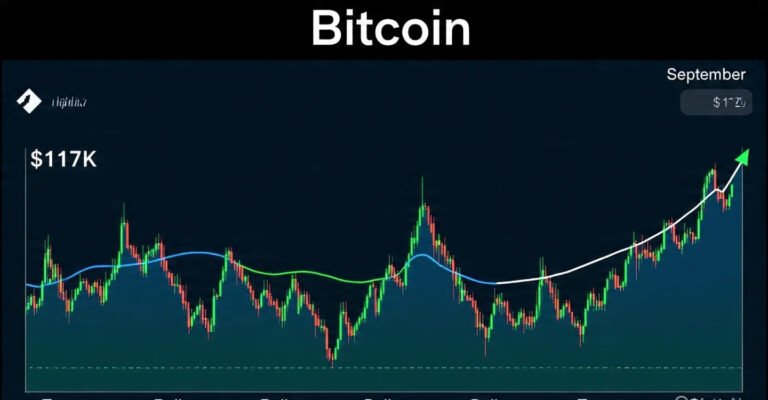The cryptocurrency market is experiencing heightened anticipation as the Bitcoin price approaches a critical juncture in September 2025. With BTC price currently navigating through significant resistance levels, market analysts and crypto investors are closely monitoring key technical indicators that could determine whether Bitcoin bulls can successfully push the digital asset toward the ambitious $117K liquidity zone.
September has historically been a pivotal month for Bitcoin Trading, often setting the tone for the final quarter’s performance. This year presents unique circumstances as institutional adoption continues to accelerate, regulatory frameworks become clearer, and blockchain technology gains mainstream acceptance. The convergence of these factors creates an environment where Bitcoin price action could experience unprecedented volatility and potentially explosive growth.
Market sentiment remains cautiously optimistic as technical analysis reveals several bullish patterns forming across multiple timeframes. The $117K target isn’t merely speculative; it represents a significant liquidity zone where substantial trading activity is expected to occur. Understanding these dynamics is crucial for both seasoned traders and newcomers to the cryptocurrency space.
The current Bitcoin market cap reflects growing institutional confidence, while on-chain metrics suggest accumulation patterns typically associated with major price movements. As we delve deeper into this analysis, we’ll examine the various factors contributing to this optimistic outlook and the potential challenges that could derail the bullish trajectory.
Current Market Analysis and Bitcoin Price Momentum
Technical Indicators Supporting the Bullish Case
Bitcoin’s technical landscape presents compelling evidence for continued upward momentum. The BTC price chart displays a series of higher lows and higher highs, forming a classic ascending triangle pattern that technical analysts often interpret as a bullish continuation signal. The 200-day moving average has provided consistent support throughout recent market corrections, reinforcing the underlying strength of the current trend.
Volume analysis reveals increasing participation during upward price movements, while selling pressure remains relatively subdued during minor retracements. This divergence suggests that Bitcoin holders are maintaining their positions despite short-term volatility, indicating firm conviction in the asset’s long-term prospects.
The Relative Strength Index (RSI) currently hovers in the upper-neutral territory, providing room for additional upward movement without entering overbought conditions. Meanwhile, the MACD indicator shows positive momentum with the signal line crossing above the baseline, traditionally considered a bullish signal for cryptocurrency trading.
On-Chain Metrics and Market Fundamentals
Bitcoin blockchain data provides additional insights into the current market dynamics. The network hash rate has reached new all-time highs, demonstrating increased mining participation and network security. This metric often correlates with price appreciation as miners invest in infrastructure based on long-term profitability expectations.
Bitcoin address activity shows consistent growth in active addresses, suggesting expanding user adoption. The number of addresses holding more than 1 BTC has increased significantly, indicating accumulation by both retail and institutional investors. This HODLing behavior typically reduces circulating supply and creates upward pressure on the BTC price.
Exchange reserves have continued declining, with major cryptocurrency exchanges reporting reduced Bitcoin holdings. This trend suggests that investors are moving their assets to cold storage, reducing immediate selling pressure and potentially setting the stage for supply and demand imbalances, or “squeeze” scenarios.
The $117K Liquidity Zone: Understanding Market Dynamics
What Constitutes a Liquidity Zone
The $117K liquidity zone represents more than just an arbitrary price target; it’s a confluence of technical and fundamental factors that create optimal conditions for significant trading activity. Market liquidity concentrates around psychological price levels, previous resistance zones, and areas where substantial options and futures contracts expire.
At the $117K level, several factors converge to create this liquidity concentration. Historical Fibonacci retracement levels from previous market cycles suggest this area as a natural resistance point. Additionally, institutional price targets from major investment firms cluster around this region, creating a self-fulfilling prophecy effect as prominent market participants position accordingly.
The options market shows significant open interest concentrated around the $117K strike price, indicating that many traders and institutions have positioned for this scenario. When price approaches such levels, the resulting gamma squeeze can accelerate price movements as market makers adjust their hedging positions.
Market Structure and Institutional Participation
Institutional Bitcoin adoption continues to drive structural changes in the market. Major corporations adding BTC to their treasury reserves, pension funds allocating portions of their portfolios to digital assets, and the continued growth of Bitcoin ETFs all contribute to reduced volatility and more sustained price trends.
The derivatives market has matured significantly, with Bitcoin futures and options providing sophisticated hedging and speculation tools. This development has attracted traditional financial institutions that previously avoided cryptocurrency markets due to concerns about risk management
The development of central bank digital currencies (CBDCs) paradoxically benefits Bitcoin, as governments exploring digital currencies inadvertently validate the concept of digital money. This institutional endorsement, while not direct, contributes to the broader acceptance of cryptocurrency as an asset class.
September’s Historical Significance for Bitcoin
Seasonal Patterns and Market Cycles
September Bitcoin performance has historically shown mixed results, but recent years have indicated improving seasonal trends. The month often serves as a consolidation period following summer volatility, setting the foundation for Q4 cryptocurrency rallies. This year’s September presents unique circumstances with increased institutional participation and clearer regulatory landscapes.
Bitcoin halving cycles continue to influence long-term price dynamics, with the current cycle positioning 2025 as a potentially significant year for price appreciation. Historical analysis suggests that approximately 18 months post-halving often coincides with peak bull market conditions, aligning with current timeframes.
The correlation between Bitcoin and traditional markets has evolved, with BTC increasingly acting as a hedge against concerns about currency debasement and inflation. This shift in market perception supports higher price targets as global economic uncertainties persist.
Regulatory Environment and Market Confidence
Cryptocurrency regulation has become increasingly favorable in major economies. The approval of spot Bitcoin ETFs in the United States marked a watershed moment for institutional adoption. Similar regulatory clarity in Europe and Asia has created a more conducive environment for institutional investment in Bitcoin.
 Government Bitcoin reserves and country-level adoption, as seen in El Salvador and potential adoption by other nations, provide fundamental support for higher price levels. These developments suggest that Bitcoin’s store-of-value proposition is gaining recognition at the highest levels of government and finance.
Government Bitcoin reserves and country-level adoption, as seen in El Salvador and potential adoption by other nations, provide fundamental support for higher price levels. These developments suggest that Bitcoin’s store-of-value proposition is gaining recognition at the highest levels of government and finance.
Risk Factors and Potential Market Challenges
Technical Resistance and Market Obstacles
Despite the bullish outlook, several factors could impede Bitcoin’s progress toward $117K. The cryptocurrency market remains susceptible to regulatory surprises, macroeconomic shifts, and technical breakdowns that could derail the upward trajectory.
Market volatility inherent in cryptocurrency trading means that even strong fundamentals don’t guarantee linear price appreciation. Potential profit-taking at psychological levels could create temporary setbacks, requiring patience from long-term Bitcoin investors.
Competition from alternative cryptocurrencies and the evolution of blockchain technologies present ongoing challenges. While Bitcoin maintains its position as digital gold, innovations in other cryptocurrencies could potentially impact market share and investment flows.
Macroeconomic Factors and Global Events
Global economic conditions have a significant impact on Bitcoin price movements. Interest rate policies, inflation data, and geopolitical events can create volatility that overrides technical factors. The correlation between Bitcoin and risk assets during market stress periods remains a consideration for investors.
Energy market dynamics impact Bitcoin mining operations and may influence the long-term sustainability of prices. Environmental concerns and regulatory pressures on mining operations present ongoing challenges that the industry continues to address through the adoption of renewable energy.
Investment Strategies and Market Positioning
Approaching the $117K Target
Cryptocurrency investors considering exposure to the potential $117K Bitcoin move should employ risk management strategies appropriate for volatile assets. Dollar-cost averaging remains a popular approach for building positions without timing concerns, while technical analysis can help identify optimal entry and exit points for more active traders.
 Portfolio allocation to Bitcoin should reflect individual risk tolerance and investment objectives. While the potential for significant gains exists, the cryptocurrency market’s volatility requires careful position sizing to avoid excessive portfolio risk.
Portfolio allocation to Bitcoin should reflect individual risk tolerance and investment objectives. While the potential for significant gains exists, the cryptocurrency market’s volatility requires careful position sizing to avoid excessive portfolio risk.
Bitcoin derivatives offer additional strategies for sophisticated investors, including covered call strategies to generate income or put options to hedge existing positions. These instruments require a thorough understanding but can enhance risk-adjusted returns for knowledgeable investors.
Conclusion
The confluence of technical indicators, fundamental developments, and market sentiment creates a compelling case for Bitcoin’s potential advance toward $117K. September’s test will likely determine whether BTC price can break through current resistance levels and establish new upward momentum.
Market participants should remain vigilant about both opportunities and risks as Bitcoin navigates this critical period. The $117K liquidity zone represents a significant milestone that could reshape cryptocurrency market dynamics and establish new precedents for digital asset valuation.
Success in reaching these levels would validate the long-term Bitcoin investment thesis and likely attract additional institutional participation. However, investors must strike a balance between optimism and realistic risk assessment, as well as appropriate position sizing, for this volatile yet potentially rewarding asset class.
The Bitcoin bull market narrative continues to gain strength, but market realities necessitate careful navigation and strategic thinking. As September unfolds, the cryptocurrency community will closely monitor price action and market developments that could determine Bitcoin’s trajectory through year-end and beyond.

